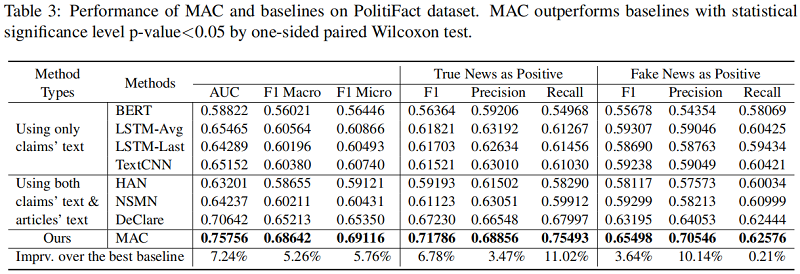虚假新闻检测(MAC)《Hierarchical Multi-head Attentive Network for Evidence-aware Fake News Detection》
论文信息
论文标题:Hierarchical Multi-head Attentive Network for Evidence-aware Fake News Detection
论文作者:Nguyen Vo, Kyumin Lee
论文来源:2021 EACL
论文地址:download
论文代码:download
1 Introduction
现有的基于证据的虚假新闻检测要么关注与词级注意力,要么关注于证据级的注意力,这将导致一个次优的结果。本文提出了一个联合结合了多头词级注意和多头文档级注意,这有助于词级和证据级的解释。
贡献:
-
- 提出了一种新的层次多头注意网络,将词注意和证据注意联合用于证据感知假新闻检测;
- 提出了一种新的多头注意机制来捕捉重要的单词和证据;
2 Problem Statement
We denote an evidence-based fact-checking dataset $\mathcal{C}$ as a collection of tuples $(c, s, \mathcal{D}, \mathcal{P})$ where $c$ is a textual claim originated from a speaker $s$, $\mathcal{D}= \left\{d_{i}\right\}_{i=1}^{k}$ is a collection of $k$ documents relevant to the claim $c$ and $\mathcal{P}=\left\{p_{i}\right\}_{i=1}^{k}$ is the corresponding publishers of documents in $\mathcal{D}$ . Note, $|\mathcal{D}|=|\mathcal{P}|$ . Our goal is to classify each tuple $(c, s, \mathcal{D}, \mathcal{P})$ into a pre-defined class (i.e. true news/fake news).
3 Framework

3.1 Embedding Layer
3.2 Multi-head Word Attention Layer
对 Evidence 使用 BiLSTM,得到 $\mathbf{h}_{j}^{d} \in \mathbb{R}^{2 H}$,将其词嵌入表示为 矩阵形式 $\mathbf{H}=\left[\mathbf{h}_{1}^{d} \oplus \mathbf{h}_{2}^{d} \oplus \ldots \oplus \mathbf{h}_{m}^{d}\right] \in \mathbb{R}^{m \times 2 H}$。
为了理解文档中的信息帮助我们对 Claim 进行事实核查,我们需要指导我们的模型关注文档中的关键字或短语。我们首先复制向量 $c $ ($Eq.1$) $m$ 次创建矩阵 $\mathbf{C}_{1} \in \mathbb{R}^{m \times 2 H}$,并提出一种注意机制,具体如下:
$\mathbf{a}_{1}=\operatorname{softmax}\left(\tanh \left(\left[\mathbf{H} ; \mathbf{C}_{1}\right] \cdot \mathbf{W}_{1}\right) \cdot \mathbf{w}_{2}\right)\quad\quad(2)$
其中,$\mathbf{w}_{2} \in \mathbb{R}^{a_{1}}$,$\mathbf{W}_{1} \in \mathbb{R}^{4 H \times a_{1}}$,$\mathbf{a}_{1} \in \mathbb{R}^{m}$ 是在 $m$ 个单词上的注意力分布。
然而,文档的总体语义可能由文档的多个部分生成。因此,我们提出一个多头词注意机制,通过将向量 $w_2$ 扩展到矩阵 $\mathbf{W}_{2} \in \mathbb{R}^{a_{1} \times h_{1}}$ 来捕获不同的语义贡献,其中 $h_1$ 为 Figure 1 所示的注意头数。修改 $\text{Eq.2}$ 具体内容如下:
其中,$\mathbf{A}_{1} \in \mathbb{R}^{m \times h_{1}}$,$\mathbf{A}_{1}$ 代表在文档 $d_i$ 中的 $m$ 个单词之上的 $h_1$ 不同的注意力分布,帮助我们捕获文档的不同方面。
在计算了 $\mathbf{A}_{1}$ 后 ,我们推导出文档 $d_i$ 的表示方式如下:
$\mathbf{d}_{i}=\operatorname{flatten}\left(\mathbf{A}_{1}^{T} \cdot \mathbf{H}\right)\quad\quad(4)$
其中,$\mathbf{d}_{i} \in \mathbb{R}^{h_{1} 2 H}$。
3.3 Multi-head Document Attention Layer
spearker 有的时候非常重要,因此将其考虑入 claim :
$\mathbf{c}^{e x t}=[\mathbf{c} ; \mathbf{s}] \in \mathbb{R}^{x} \quad\quad(5)$
其中,$x = 2 H+D_{1}$。
同样 publisher 对于 Evidence 的真实性也有很大的帮助,所以:
$\mathbf{d}_{i}^{e x t}=\left[\mathbf{d}_{i} ; \mathbf{p}_{i}\right] \in \mathbb{R}^{y} \quad\quad(6)$
其中,$y= 2 h_{1} H+D_{2}$。
从 $\text{Eq.6}$ 开始,我们可以生成 $k$ 个相关文章的表示,并堆栈,如 $\text{Eq.7}$ 所示:
$\mathbf{D}=\left[\mathbf{d}_{1}^{e x t} \oplus \ldots \oplus \mathbf{d}_{k}^{e x t}\right] \in \mathbb{R}^{k \times y}\quad\quad(7)$
3.4 Multi-head Document Attention Mechanism
即使选择了 $k$ 个最相关的文章来判别 claim $c$ 的真实性,但是实际上往往只有个别几篇文章被用于判断 claim $c$ 的真实性,所以本文再一次使用注意力机制来选择合适的 documnet。
首先通过将 $\mathbf{c}^{e x t}$ 复制 $k$ 次,得到 $\mathbf{C}_{2} \in \mathbb{R}^{k \times x}$,然后将其与 $D$ ($\text{Eq.7}$) 拼接得到 $\left[\mathbf{D} ; \mathbf{C}_{2}\right] \in \mathbb{R}^{k \times(x+y)}$。
我们提出的多头文档级注意机制应用了 $h_2$ 个不同的注意头,如 $\text{Eq.8}$ 所示:
$\mathbf{A}_{2}=\operatorname{softmax}_{c o l}\left(\tanh \left(\left[\mathbf{D} ; \mathbf{C}_{2}\right] \cdot \mathbf{W}_{3}\right) \cdot \mathbf{W}_{4}\right)$
其中,$\mathbf{W}_{3} \in \mathbb{R}^{(x+y) \times a_{2}}$、$\mathbf{W}_{4} \in \mathbb{R}^{a_{2} \times h_{2}}$、$\mathbf{A}_{2} \in \mathbb{R}^{k \times h_{2}}$ 。
使用注意权重,我们可以生成 $k$ 个证据的参与表示,表示为 $\mathbf{d}^{r i c h} \in \mathbb{R}^{h_{2} y}$,如 $\text{Eq.9}$ 所示:
$\mathbf{d}^{\text {rich }}=\operatorname{flatten}\left(\mathbf{A}_{2}^{T} \cdot \mathbf{D}\right)\quad\quad(9)$
3.5 Output Layer
将 $ \left[\mathbf{c}^{e x t} ; \mathbf{d}^{\text {rich }}\right]$ 作为 MLP 的输入,计算 claim 真实性的概率:
$\hat{y}=\sigma\left(\mathbf{W}_{6} \cdot\left(\mathbf{W}_{5} \cdot\left[\mathbf{c}^{\text {ext }} ; \mathbf{d}^{\text {rich }}\right]+\mathbf{b}_{5}\right)+\mathbf{b}_{6}\right)\quad\quad(10)$
采用交叉熵优化模型:
$\mathcal{L}_{\theta}(y, \hat{y})=-(y \log \hat{y}+(1-y) \log (1-\hat{y}))\quad\quad(11)$
4 Experiment

Note:Each Snopes claim was labeled as true or false while in Politifact, there were originally six labels: true, mostly true, half true, false, mostly false, pants on fire. Following (Popat et al., 2018), we merge true, mostly true and half true into true claims and the rest are into false claims.
Using only claims’ text:
-
- BERT
- LSTM-Last
- LSTM-Avg
- CNN
-
- DeClare
- HAN
- NSMN
Performance of MAC and baselines


相关文章
- Cinema 4D R26 for Mac(c4d r26)中文版安装教程
- Synalyze It! Pro Mac(二进制编辑器)v1.24
- mac文件同步对比工具Beyond Compare 4 for Mac
- Termius for Mac(SSH客户端)7.34.1中文正式版
- Illustrator 2022 for Mac(Ai 2022)v26.4.1中文激活版
- DropSync 3 for Mac(数据同步备份软件) v3.2.5激活版
- TG Pro for mac(Mac硬件温度检测工具)v2.72激活版
- TG Pro for mac(Mac硬件温度检测工具)v2.73激活版
- AnyTrans 8 for mac(专业的ios数据传输工具)激活版
- CleanMyMac X for mac(Mac垃圾清理系统优化工具)
- ON1 Photo RAW 2023 for Mac(照片编辑器) 17.1.0.13508激活版
- Default Folder X for Mac(mac专业搜索优化工具)v6.0d21激活版
- mac虚拟机pd18完美激活版Parallels Desktop 18 for Mac 永久证书版
- AlDente for Mac(mac电池最大充电限制工具)
- AutoCAD 2023 for Mac(cad2023)
- Mac截图标注软件-TechSmith Snagit for mac 永久版下载
- mac小而美的软件卸载删除工具 AppCleaner for Mac 中文版
- mac最大充电限制保护工具-AlDente for Mac 永久版
- ProtoPie for Mac(交互原型设计工具) 功能介绍
- YouTube客户端Mac版:YouTube for mac
- 循环使用Oracle数组实现For循环(oracle数组for)
- Mac上使用MSSQL:限制登录权限绑定MAC地址(mssql绑定mac地址)

